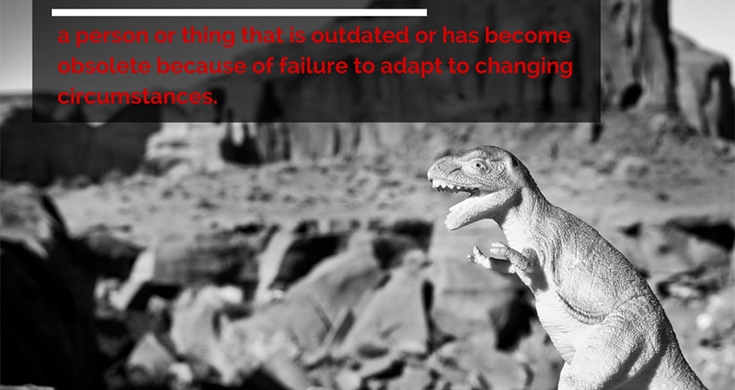Are You a Dinosaur?
We see them all around us. Maybe in our own office. Maybe in our family. Maybe in our vendors.
Or, maybe it’s us.
In this post, I will give you 5 areas that you can test yourself for dinosaur-ism. As I always say, this isn’t meant to shame…only to help. As a coach/consultant, I get asked to come into companies and help them grow, sometimes exponentially. And to do that, they MUST let go of old behaviors that prohibit that growth. I call it “dinosaurism.”
Example of Company Dinosaurism
I went in to a chiropractor’s office last week to order orthotics. Have been having some real foot problems and my chiro assured me that they have the best orthotics around. But what I found was ‘dinosaurism.’
1. When I got there during office hours, no one at the front desk to help. So I waited (20 minutes).
2. When someone finally arrived, I was told that she had no idea where the doctor was. Oh, that’s reassuring.
3. In 15 minutes, in he walks, no greeting. No acknowledgement for wait. Boy, do I feel good about this decision.
4. When in the exam room, he asks me to take off shoes and take one step on a platform which is supposed to sense my custom orthotic profile. One step. Not two to make sure the first one took. Just one. I felt some real pressure to ‘walk right.’
5. I kept asking questions to make sure this was the right thing to do. Few answers. None good.
6. No proactive notice about when they’d be done. How much they were. What the guarantee was. I had to pull it out of him.
7. Left very unsatisfied and not very hopeful.
Bottom line: I had purchased orthotics from a Dinosaur.
What About You?
Just as you can be a dinosaur, so can your company. Obviously, the company dinosaurism is merely a compilation of individual dinosaur-behavior. Here is a checklist of 5 small things you can do to extract yourself from this deadly condition.
1. Tell Customers (Prospects) How Things Work. It’s very simple. Just have a process documen that you walk your customers through as they’re buying. It’s too easy for customers to leave if they don’t feel like they’re a part of a process that is designed to get their problem solved. I have a client who has created such a document that includes 5 Steps. She goes through it step-by-step. That way, they are clear about what’s about to happen to them.
2. Make Me Feel Something. Buying is about an emotional construct of the customer. How do they feel in your presence? Or the presence of your firm? Last week I walked into an office I’d been in only two other times. The person behind the desk looks up, smiles and says, “Bill Caskey, right?” Isn’t that better than the front desk person who barely looks up and says, “What can I help you with?”
3. Follow Up a Meeting With Notes. I know great sales people do this all the time. But how often do you really get an eloquent follow up? Rarely, I bet. Why? It’s work. It requires someone to transfer what they heard in a meeting to a document, proof it, and send it. Average sales people are pathetic at this. They’re, mistakenly, on to their next prospect.
4. Acknowledge Me For Being There. So simple yet so missed. Dan Sullivan (The Strategic Coach) says, “What you appreciate, appreciates.” So, when you say to your prospect/customer, “Hey, Charlie, before we begin today, I just want to thank you for inviting me in. I’m looking forward to this.” How long did that take? 2.5 seconds? Time well spent.
5. Craft Thoughtful Questions. Questions are the tools of your trade as a business. ‘What’ you ask and ‘how’ you ask tells a lot about you as a server-of-people. Even something simple as “What brings you in today?” can be effective. If you invited yourself in, then a simple question like, “Before I begin Sean, do you have any questions to begin the meeting?” Or, “Did you have some specific things you wanted to accomplish today?” See how easy that is? But think about the impact that has. It says, “I care enough about you that I’ll let you go first and share what’s on your mind.”
So there you have it. A quick way to remove yourself from the dinosaur era. I’ll have more in coming weeks.
What do you see companies do that indicates dinosaurism? What about you? Anything you’ve done for 20 years that you need to stop doing?



Really good review Bill, thank you for the concise points. Especially the process point (1) is one that we can probably all do better on.
Excellent post….thank you